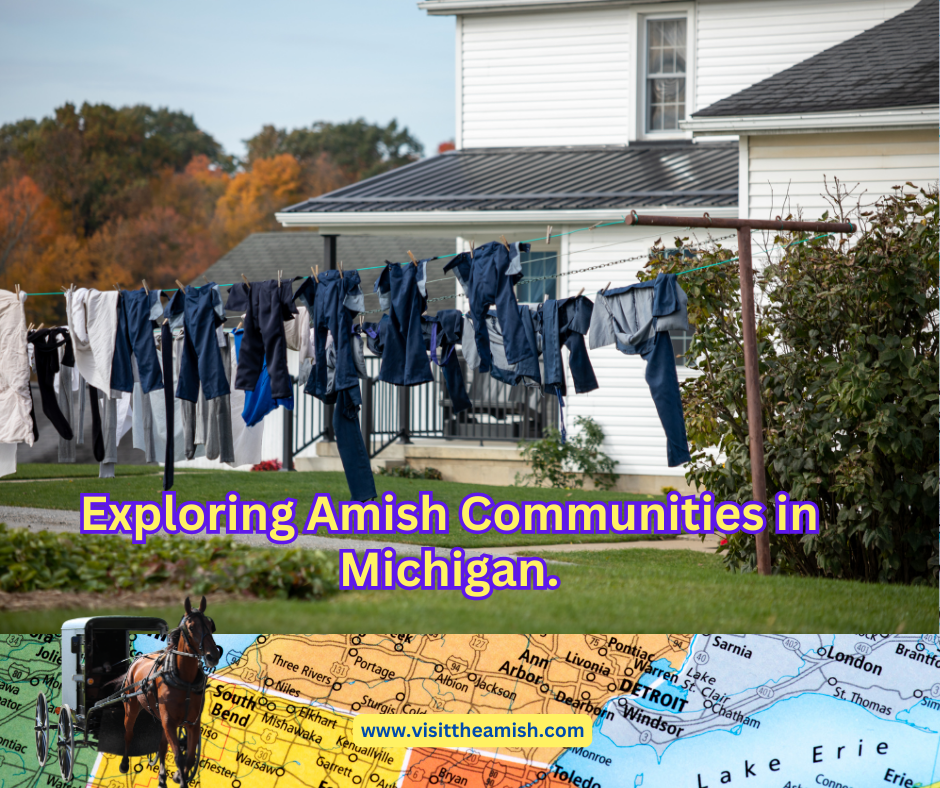Ohio’s Amish Country Wineries: A Unique Blend of Tradition and Taste
Ohio’s Amish Country, nestled in the heart of the Buckeye State, offers a delightful fusion of old-world charm and modern indulgence. Home to the second-largest Amish settlement globally, this picturesque countryside boasts not only horse-drawn carriages and homemade delicacies but also a thriving wine scene. With over 300 wineries across Ohio, the region is a haven for wine enthusiasts seeking a unique tasting experience.
Exploring the Wineries
Venturing through Ohio’s Amish Country, you’ll encounter a diverse array of wineries that promise unforgettable moments. From the trendy Winetagous in Sugarcreek to the educational Silver Moon Winery in Dover, each winery offers a distinct ambiance and a selection of handcrafted wines. Whether you’re savoring dandelion wine at Winetagous or enjoying the dry red 1814 at Silver Moon Winery, the region’s wineries cater to every palate.
Planning Your Visit
To make the most of your winery tour in Ohio’s Amish Country, consider mapping out your route strategically. Many wineries are conveniently located near popular tourist attractions like Berlin, Walnut Creek, and Sugarcreek. Keep in mind that most businesses in this area are closed on Sundays, so plan your visits accordingly to avoid any disappointments.
Indulging in Local Flavors
In addition to exceptional wines, Ohio’s Amish Country offers a culinary delight with locally-made cheeses and gourmet foods that perfectly complement your wine tastings. Pair your favorite wines with high-quality cheeses at Han’s Place or savor wood-fired pizzas at Café Breitenbach for a complete sensory experience.
Embracing Tradition and Innovation
The wineries in Ohio’s Amish Country beautifully blend tradition with innovation. While honoring their roots in winemaking, these establishments also embrace modern techniques to produce an impressive variety of wines that cater to different preferences. From sweet dandelion wines to robust red blends, each sip tells a story of craftsmanship and dedication.
Embark on a journey through Ohio’s Amish Country wineries to discover the rich tapestry of flavors, hospitality, and culture that define this unique region. Whether you’re a wine connoisseur or simply seeking a memorable getaway, this charming countryside promises an enriching experience that tantalizes the senses and warms the soul.
The most popular wine varieties in Ohio’s Amish Country include a diverse selection that caters to different tastes. Some notable wineries in the region offer a range of wines that have gained popularity among visitors:
- Winetagous in Sugarcreek is known for producing unique wines, including dandelion wine, a sweet and delicate pale yellow wine made from dandelions, which is a local favorite3.
- Silver Moon Winery in Dover offers over 40 different wine styles, with standout options like their dry red wine called 1814 and their best-selling sweet red wine named Down the Rabbit Hole3.
- Sunny Slope Winery in Big Prairie is a family-owned winery that has been producing quality wines for generations, offering a variety of wines that appeal to different preferences3.
- Britenbach Winery in Dover
- School House Winery near Dover
- Raven’s Glenn
These wineries showcase the diversity and quality of wines available in Ohio’s Amish Country, providing visitors with an enriching tasting experience that highlights both traditional and innovative winemaking techniques.
Winetagous
Here are some distinctive aspects of Winetagous:
- Location and Atmosphere: Winetagous is located in a little brick strip mall in the heart of Sugarcreek, one of Ohio’s most visited Amish locations. Despite its unassuming exterior, the winery exudes a laid-back and welcoming vibe as soon as you step inside 3.
- Ownership and Concept: Founded by two married couples, Tammy and Mick, and Heide and Steve, who shared a passion for wine-making as a hobby, Winetagous offers an intimate and trendy setting for wine enthusiasts. The winery is open on Fridays and Saturdays year-round, with live music every Saturday, creating a vibrant and engaging atmosphere for visitors 3.
- Outdoor Patio: Winetagous features a surprisingly large outdoor patio where guests can enjoy entertainment and wine tastings when the weather is favorable. This outdoor space adds to the charm of the winery and provides a relaxing environment for patrons to unwind and socialize 3.
- Unique Wine Selection: Winetagous offers a variety of wines that appeal to different tastes, including seasonal wines like Strawberry Wine, Watermelon Crawl, and Holmes County Blues (a blueberry wine). One of their popular wines is River Rat, a sweet red wine with a subtle hint of cotton candy aftertaste 3.
- Entertainment and Amenities: In addition to wine tastings, Winetagous provides entertainment options such as live music on Saturdays. The winery also offers indoor seating with leather chairs and board games for guests who prefer a more laid-back experience or want to catch a game while enjoying snacks 3.
Winetagous in Sugarcreek combines a relaxed ambiance, unique wine selection, and engaging entertainment to create a memorable and enjoyable experience for visitors looking to explore Ohio’s Amish Country wineries.
Silver Moon Winery: A Hidden Gem in Dover
Nestled amidst the picturesque landscapes of Dover, Ohio, lies a true haven for wine enthusiasts and nature lovers alike – Silver Moon Winery. With its serene ambiance, award-winning wines, and commitment to sustainability, Silver Moon Winery stands as a testament to the passion and dedication of its founders, the Smith family.
Silver Moon Winery traces its roots back to 2009 when the Smith family embarked on a journey to transform their love for wine into a thriving business. What began as a modest venture has since blossomed into one of Dover’s most beloved destinations, renowned for its premium wines and warm hospitality.
Central to Silver Moon Winery’s success is its dedication to producing high-quality wines from locally sourced grapes. The winery boasts sprawling vineyards spanning several acres, where a variety of grapes, including Chardonnay, Cabernet Sauvignon, and Riesling, thrive under the Ohio sun.
At Silver Moon Winery, winemaking is both an art and a science. Guided by traditional techniques and modern innovation, the skilled winemakers meticulously craft each bottle to perfection. From hand-selecting the finest grapes to fermenting and aging the wine in oak barrels, every step is carefully executed to ensure exceptional taste and quality.
Silver Moon Winery offers an impressive selection of wines to suit every palate. Whether you prefer a crisp, refreshing white or a bold, full-bodied red, there’s something for everyone to enjoy. Some of their signature wines include:
- Moonlight Sonata: A delightful blend of Chardonnay and Pinot Grigio, exuding notes of pear and citrus with a hint of vanilla.
- Silver Eclipse: This robust Cabernet Sauvignon boasts rich flavors of blackberry, cherry, and dark chocolate, with a smooth, lingering finish.
- Lunar Harvest: A semi-sweet Riesling with aromas of ripe peach and honeysuckle, balanced by a crisp acidity and vibrant fruit flavors.
Beyond crafting exceptional wines, Silver Moon Winery is committed to sustainability and environmental stewardship. From implementing water conservation measures in the vineyards to utilizing eco-friendly packaging, every effort is made to minimize the winery’s ecological footprint and preserve the natural beauty of the surrounding area.
Visiting Silver Moon Winery is not just about savoring exquisite wines; it’s an immersive experience that engages all the senses. The winery’s charming tasting room invites guests to sample an array of wines while soaking in the rustic ambiance and breathtaking views of the vineyards. Knowledgeable staff members are on hand to guide visitors through the tasting process, offering insights into the winemaking techniques and flavor profiles of each wine.
Silver Moon Winery is more than just a place to enjoy wine; it’s a vibrant community hub where friends and families come together to celebrate life’s special moments. From live music performances and wine pairing dinners to seasonal festivals and private events, there’s always something exciting happening at the winery.
Discovering the Charms of Sunny Slope Winery in Big Prairie
Tucked away in the scenic countryside of Big Prairie, Ohio, lies a hidden gem waiting to be explored by wine enthusiasts and nature lovers alike – Sunny Slope Winery. With its rolling vineyards, award-winning wines, and inviting ambiance, Sunny Slope Winery offers a unique and unforgettable experience for visitors seeking a taste of Ohio’s wine country charm.
As you journey through the winding roads of Big Prairie, you’ll find yourself entranced by the natural beauty that surrounds you. Tucked amidst the gently sloping hills and lush greenery, Sunny Slope Winery emerges as a tranquil oasis, beckoning travelers to leave their cares behind and immerse themselves in the beauty of the countryside.
Sunny Slope Winery’s story is one of passion, perseverance, and a deep-rooted love for the land. Founded by the Smith family in 2007, the winery began as a labor of love, with a vision to create exceptional wines that reflect the unique terroir of the region. Over the years, Sunny Slope Winery has grown into a beloved destination, known for its commitment to quality and hospitality.
At the heart of Sunny Slope Winery lies its meticulously tended vineyards, where a variety of grape varietals thrive in the Ohio sun. From the classic Cabernet Sauvignon and Chardonnay to lesser-known gems like Vidal Blanc and Catawba, the vineyards boast a diverse array of grapes, each contributing to the rich tapestry of flavors found in Sunny Slope’s wines.
Winemaking at Sunny Slope Winery is a blend of tradition and innovation, guided by a commitment to excellence. From hand-harvesting the grapes to carefully monitoring the fermentation process, every step is undertaken with meticulous attention to detail to ensure that each bottle reflects the true essence of the land.
Sunny Slope Winery offers a diverse selection of wines to suit every palate, from crisp whites to bold reds and everything in between. Some of their signature wines include:
- Sunrise Symphony: A refreshing blend of Vidal Blanc and Cayuga, boasting tropical fruit flavors and a crisp, clean finish.
- Sunset Serenade: This rich and velvety Cabernet Sauvignon enchants the palate with notes of blackberry, plum, and vanilla, culminating in a smooth, lingering finish.
- Harvest Moon Rosé: A delightful rosé made from Catawba grapes, featuring vibrant notes of strawberry, watermelon, and citrus, perfect for sipping on a sunny afternoon.
Step into the inviting ambiance of Sunny Slope Winery’s tasting room, where warm hospitality and exquisite wines await. Guests are invited to sample a selection of wines while taking in panoramic views of the vineyards and surrounding countryside. Knowledgeable staff members are on hand to guide visitors through the tasting experience, offering insights into the winemaking process and the unique characteristics of each wine.
Throughout the year, Sunny Slope Winery plays host to a variety of events and activities, from live music performances and wine pairing dinners to vineyard tours and festivals. Whether you’re celebrating a special occasion or simply looking for a relaxing weekend getaway, there’s always something exciting happening at Sunny Slope Winery.
For those seeking an escape from the hustle and bustle of everyday life, Sunny Slope Winery offers a serene retreat amidst the natural beauty of Ohio’s countryside. With its exceptional wines, breathtaking views, and warm hospitality, it’s no wonder that Sunny Slope Winery has become a beloved destination for wine lovers and travelers alike. So, pack your bags, hit the road, and embark on a journey of discovery to Sunny Slope Winery in Big Prairie. Your taste buds will thank you.
Britenbach Winery in Dover
Nestled in the heart of Dover, Ohio, Britenbach Winery beckons travelers to experience the charm and flavor of Ohio’s wine country. With its rich history, scenic vineyards, and exceptional wines, Britenbach Winery offers a delightful escape for wine enthusiasts and adventurers alike.
Founded in 1981 by the Britenbach family, the winery has deep roots in the Dover community. What began as a modest vineyard has blossomed into a beloved destination, renowned for its commitment to quality and innovation. Today, Britenbach Winery stands as a testament to the passion and perseverance of its founders, who have dedicated themselves to crafting exceptional wines that reflect the unique terroir of the region.
Spanning acres of rolling hills and fertile soil, Britenbach Winery’s vineyards are a sight to behold. Here, a variety of grape varietals, including Riesling, Chardonnay, and Cabernet Sauvignon, thrive under the Ohio sun, producing grapes of unparalleled quality and flavor. From bud break to harvest, the vineyards come alive with the rhythm of the seasons, offering visitors a glimpse into the artistry of winemaking.
At Britenbach Winery, winemaking is both a science and an art. Guided by tradition and innovation, the skilled winemakers meticulously handcraft each bottle to perfection. From the careful selection of grapes to the precise blending and aging process, every step is undertaken with a dedication to quality and craftsmanship, resulting in wines that are as exceptional as they are memorable.
Britenbach Winery offers an impressive selection of wines to suit every palate, from crisp whites to robust reds and everything in between. Some of their signature wines include:
- Sunburst Riesling: A refreshing Riesling with vibrant citrus notes and a hint of sweetness, perfect for sipping on a warm summer day.
- Heritage Chardonnay: This elegant Chardonnay entices with aromas of ripe apple and vanilla, leading to a creamy, well-balanced palate.
- Dover Sunset: A bold blend of Cabernet Sauvignon and Merlot, boasting flavors of blackberry, cherry, and spice, with a velvety smooth finish.
Step into the inviting ambiance of Britenbach Winery’s tasting room, where warm hospitality and exquisite wines await. Guests are invited to sample a selection of wines while soaking in the rustic charm of the surroundings. Knowledgeable staff members are on hand to guide visitors through the tasting experience, offering insights into the winemaking process and the unique characteristics of each wine.
Throughout the year, Britenbach Winery hosts a variety of events and activities, from wine pairing dinners and live music performances to vineyard tours and seasonal festivals. Whether you’re celebrating a special occasion or simply looking for a relaxing day out, there’s always something exciting happening at Britenbach Winery.
School House Winery near Dover
Nestled in the rolling hills near Dover, Ohio, lies a hidden gem waiting to be discovered by wine enthusiasts and travelers alike – School House Winery. With its historic charm, picturesque surroundings, and exceptional wines, School House Winery offers a delightful escape for those seeking a taste of Ohio’s wine country.
Step back in time as you arrive at School House Winery, housed within a beautifully restored 19th-century schoolhouse. Originally built in 1886, the building exudes rustic charm and character, providing a unique backdrop for wine tasting and relaxation. Whether you’re exploring the cozy interior or strolling through the scenic grounds, you’ll find yourself enchanted by the timeless allure of this historic establishment.
Surrounding the schoolhouse, acres of meticulously tended vineyards stretch out as far as the eye can see. Here, a variety of grape varietals thrive in the fertile soil and temperate climate, soaking up the Ohio sun and developing rich, complex flavors. From classic Chardonnay and Cabernet Sauvignon to lesser-known gems like Vidal Blanc and Traminette, the vineyards at School House Winery offer a diverse array of grapes, each contributing to the unique character of the wines.
At School House Winery, winemaking is a labor of love, guided by a passion for quality and craftsmanship. From vine to bottle, every step of the winemaking process is carefully overseen by the talented team of winemakers. Hand-harvested grapes are gently pressed and fermented, then aged to perfection in oak barrels, resulting in wines of exceptional flavor and complexity.
School House Winery boasts an impressive selection of wines, ranging from crisp whites to bold reds and everything in between. Some of their signature wines include:
- Teacher’s Pet Chardonnay: A classic Chardonnay with notes of apple, pear, and vanilla, balanced by a crisp acidity and lingering finish.
- Principal’s Port: This rich and velvety port-style wine boasts flavors of dark chocolate, black cherry, and toasted almonds, perfect for sipping by the fireside on a chilly evening.
- Vineyard Valedictorian Merlot: A smooth and elegant Merlot with aromas of plum, blackberry, and spice, leading to a soft, supple palate and long, satisfying finish.
Step inside the inviting tasting room at School House Winery, where warm hospitality and exceptional wines await. Guests are invited to sample a selection of wines while taking in the historic ambiance and scenic views of the surrounding countryside. Knowledgeable staff members are on hand to guide visitors through the tasting experience, offering insights into the winemaking process and the unique characteristics of each wine.
Throughout the year, School House Winery hosts a variety of events and activities, from wine pairing dinners and live music performances to art exhibits and educational seminars. Whether you’re celebrating a special occasion or simply looking for a relaxing day out, there’s always something exciting happening at School House Winery.
Raven’s Glenn Winery, West Lafayette, Ohio
Nestled in the rolling hills of Ohio’s wine country, Raven’s Glenn Winery beckons travelers to discover its hidden charms and exquisite wines. With its picturesque vineyards, elegant tasting room, and warm hospitality, Raven’s Glenn Winery offers a captivating escape for wine enthusiasts and adventurers alike.
As you approach Raven’s Glenn Winery, you’ll be greeted by the sight of lush vineyards stretching across the landscape, their vibrant green leaves dancing in the breeze. Nestled among the vines, the winery itself exudes elegance and charm, with its stately architecture and inviting ambiance. Whether you’re seeking a romantic retreat or a fun-filled day out with friends, Raven’s Glenn Winery promises an experience to remember.
Founded in 1995 by the Ranier family, Raven’s Glenn Winery is steeped in a rich tradition of winemaking excellence. Inspired by their love for the land and a passion for quality, the Ranier family set out to create wines that reflect the unique terroir of the region. Today, Raven’s Glenn Winery stands as a testament to their dedication, offering a diverse selection of wines crafted with care and expertise.
At the heart of Raven’s Glenn Winery lies its meticulously tended vineyards, where a variety of grape varietals thrive in the fertile soil and temperate climate. From classic Cabernet Sauvignon and Chardonnay to lesser-known gems like Traminette and Norton, the vineyards boast a diverse array of grapes, each contributing to the rich tapestry of flavors found in Raven’s Glenn’s wines.
Winemaking at Raven’s Glenn Winery is a blend of art and science, guided by a commitment to excellence and innovation. From hand-harvesting the grapes to carefully monitoring the fermentation process, every step is undertaken with meticulous attention to detail to ensure that each bottle reflects the true essence of the land. The result is a collection of wines that are as elegant as they are memorable, each one a testament to the skill and dedication of the winemakers.
Raven’s Glenn Winery offers an impressive selection of wines to suit every palate, from crisp whites to bold reds and everything in between. Some of their signature wines include:
- Raven’s Reserve Chardonnay: A sophisticated Chardonnay with aromas of tropical fruit and vanilla, leading to a creamy, well-rounded palate and a lingering finish.
- Blackbird Red Blend: This velvety red blend boasts flavors of black cherry, plum, and spice, with soft tannins and a long, satisfying finish.
- Raven’s Reflection Ice Wine: A luxurious dessert wine made from frozen grapes, featuring intense flavors of honey, apricot, and citrus, with a lusciously sweet finish.
Step into the elegant tasting room at Raven’s Glenn Winery, where warm hospitality and exceptional wines await. Guests are invited to sample a selection of wines while taking in panoramic views of the vineyards and surrounding countryside. Knowledgeable staff members are on hand to guide visitors through the tasting experience, offering insights into the winemaking process and the unique characteristics of each wine.
Throughout the year, Raven’s Glenn Winery hosts a variety of events and activities, from wine pairing dinners and live music performances to vineyard tours and seasonal festivals. Whether you’re celebrating a special occasion or simply looking for a relaxing day out, there’s always something exciting happening at Raven’s Glenn Winery.
Like this:
Like Loading...























